How to Tan A Rabbit Hide
This post may contain affiliate links, view our disclosure policy for details.
In this post, I will show you how to tan a rabbit hide. You can use this method to tan any small animal hide. This is fur-on tanning, which means we are leaving the fur on the hide. Let’s do this!
I have ruined eight rabbit hides in the past year. Do you know that emoji with the girl slapping herself on the forehead? That’s what I would have inserted here if I could. I’ve asked forgiveness from all those eight rabbits but I’m happy to report that the ninth hide was a success and I would like to share this success with you!
My journey in tanning started with learning how to tan a deer hide since I couldn’t bear the thought of just throwing away the hides after we butchered deer in the fall. It took me a few hides to feel comfortable with brain tanning and making buckskin.
How to Tan a Rabbit Hide…
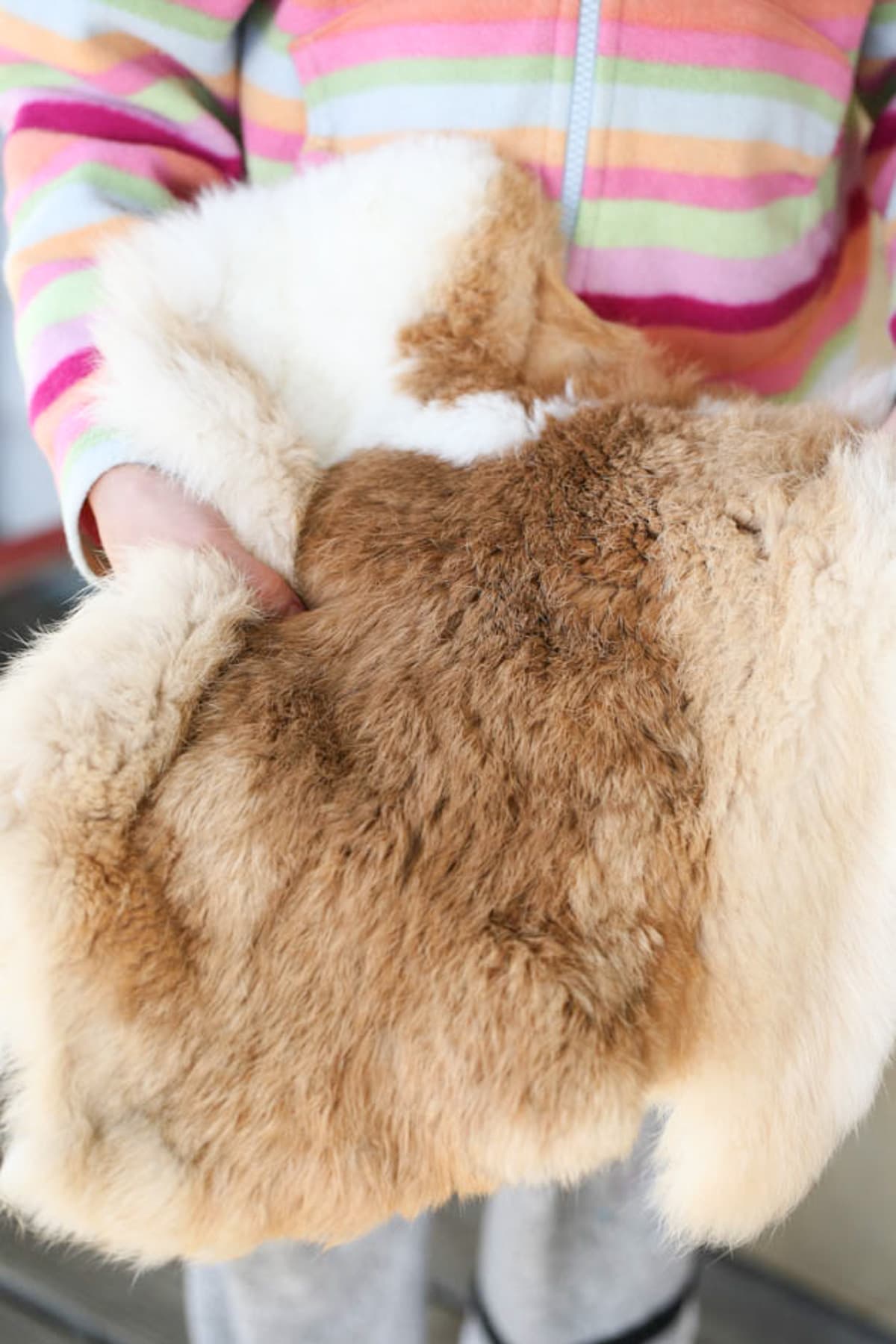
All of my deer hide tanning included taking the hair off the hide and naturally, I was also curious to learn how to do this with the fur on… a rabbit is perfect for that! My friend raises rabbits for meat so I asked her to give me the hides after they butchered their rabbits.
Is This the Only Way?
I tried a few different ways but was looking for a simple way to tan a hide, fur-on, without needing to look for products like alum and such (tanning rabbit hides with salt and alum and borax are some common ways you’ll come across if you search online for tanning tutorials).
Before we start going through the steps of tanning a rabbit hide, let me just say that this is how I do this, it’s not the only way to do it. They say that if you ask a dozen hide tanners how to tan a hide you will get a dozen different answers. This is true, I think.
Hide tanning is an art, and in art, there is no wrong way and there is no one way. If it works for you it works, that’s all there is to it.
I’ve tried a few ways of tanning in the past and I’ll keep trying and experimenting with different ways, but for now, this process of tanning that I am about to share with you works well for me for small hides.
Tools You’ll Need…
- A butchering knife – for skinning the rabbit.
- Fleshing knife – to flesh the hide.
- Work beam – you need to make sure that you have a proper work area. This will make your life so much easier. You’ll see my beam in the photos below. It was made from a simple PVC pipe and two cedar posts.
- Gloves
- Apron
- Dish soap – we need two drops for the second rinse.
- Plywood – we are going to pin and stretch the hide on this board so make sure that it is large enough.
- Nails and a hammer – we are going to use the nails to hold the hide stretched on the plywood. It doesn’t matter what nails you are using, however, thin nails will do best.
- Hair dryer – to speed up the drying process.
- Hair brush – to brush the fur as we dry it.
- Egg yolk – to “brain” the hide. More on that later.
- A bowl – just a small bowl for the egg yolk.
- Pastry brush – to apply the egg yolk.
Tanning a Rabbit Hide Step-by-Step…
Step one – skin the rabbit. First, we have to get the hide off the animal. I go into more detail on how to skin a rabbit in my How to Butcher a Rabbit post so make sure to head over there and take a look.
In short, hang your animal from its back legs, cut the skin right under the back legs joint, and then continue in a V shape towards the center of the tummy, between the two hind legs. From there move in a straight line down the stomach until you get to the neck. Cut the head off and you are left with the hide.
Step two – rinse the hide. The next thing we want to do is to rinse the hide. You don’t need to use soap or anything else in this first rinse, just cold water.
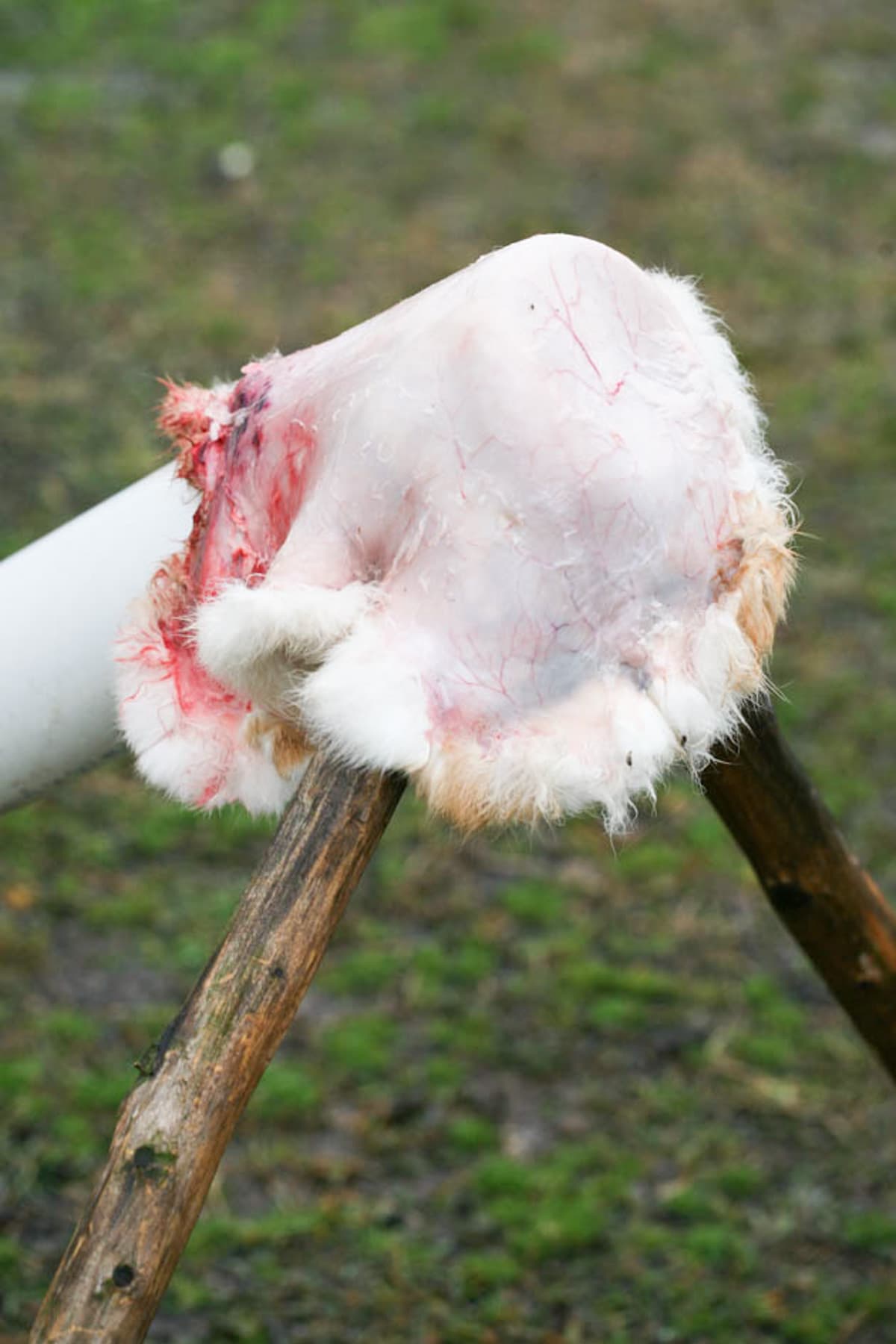
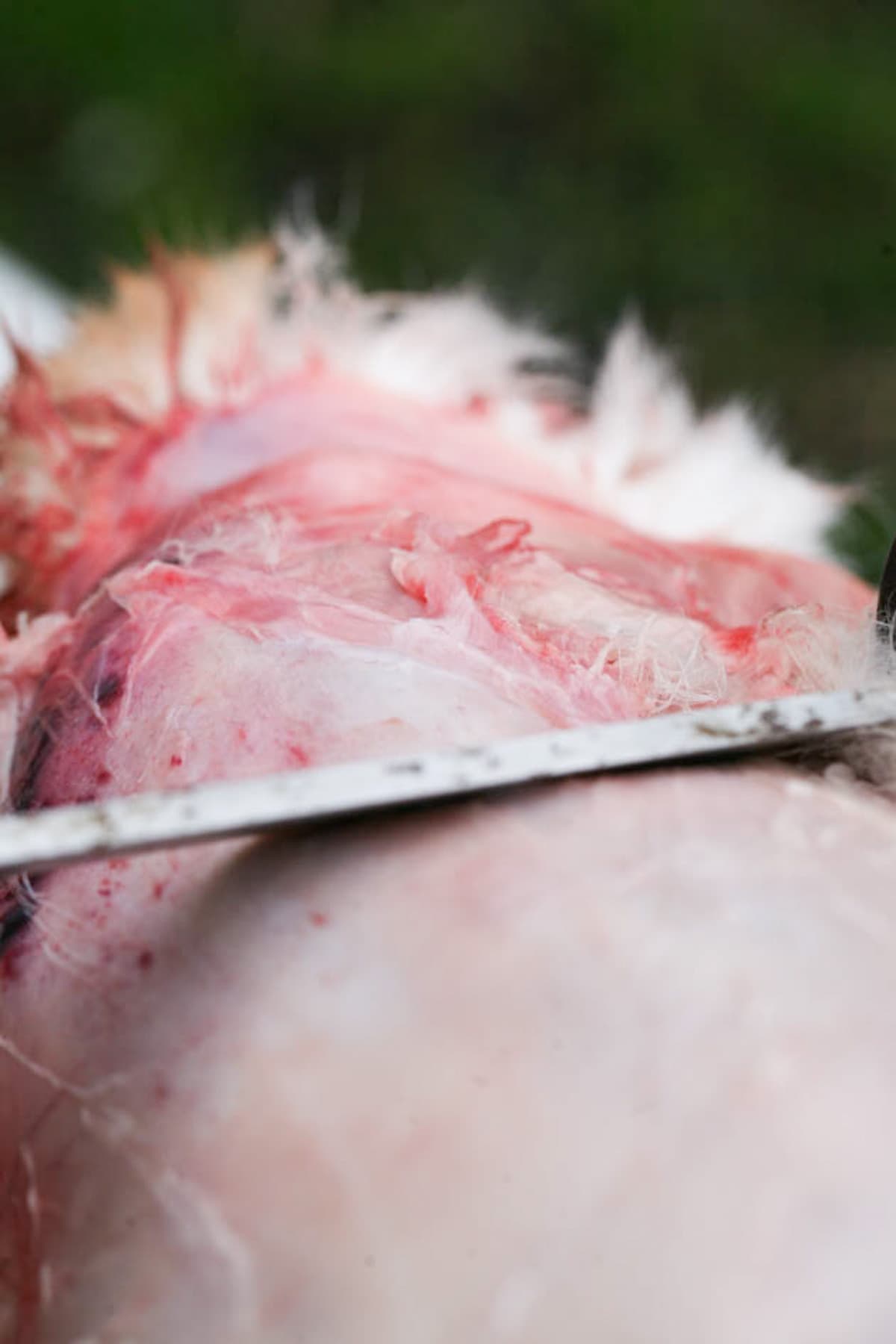
Step three – flesh the hide. Fleshing is removing all the flesh and fat from the skin. A fleshing knife (linked above) has a very dull edge, not sharp at all. You can also use a piece of dull metal or a spoon or a butter knife.
Whatever you use, our objective here is to scrape the flesh off of the skin gently. Place the hide on the beam (which is simply made from a 4? PVC pipe and a couple of cedar logs), and hold the hide to the beam with your body (that is covered with the apron…), then, gently scrape the flesh off the skin away from you.
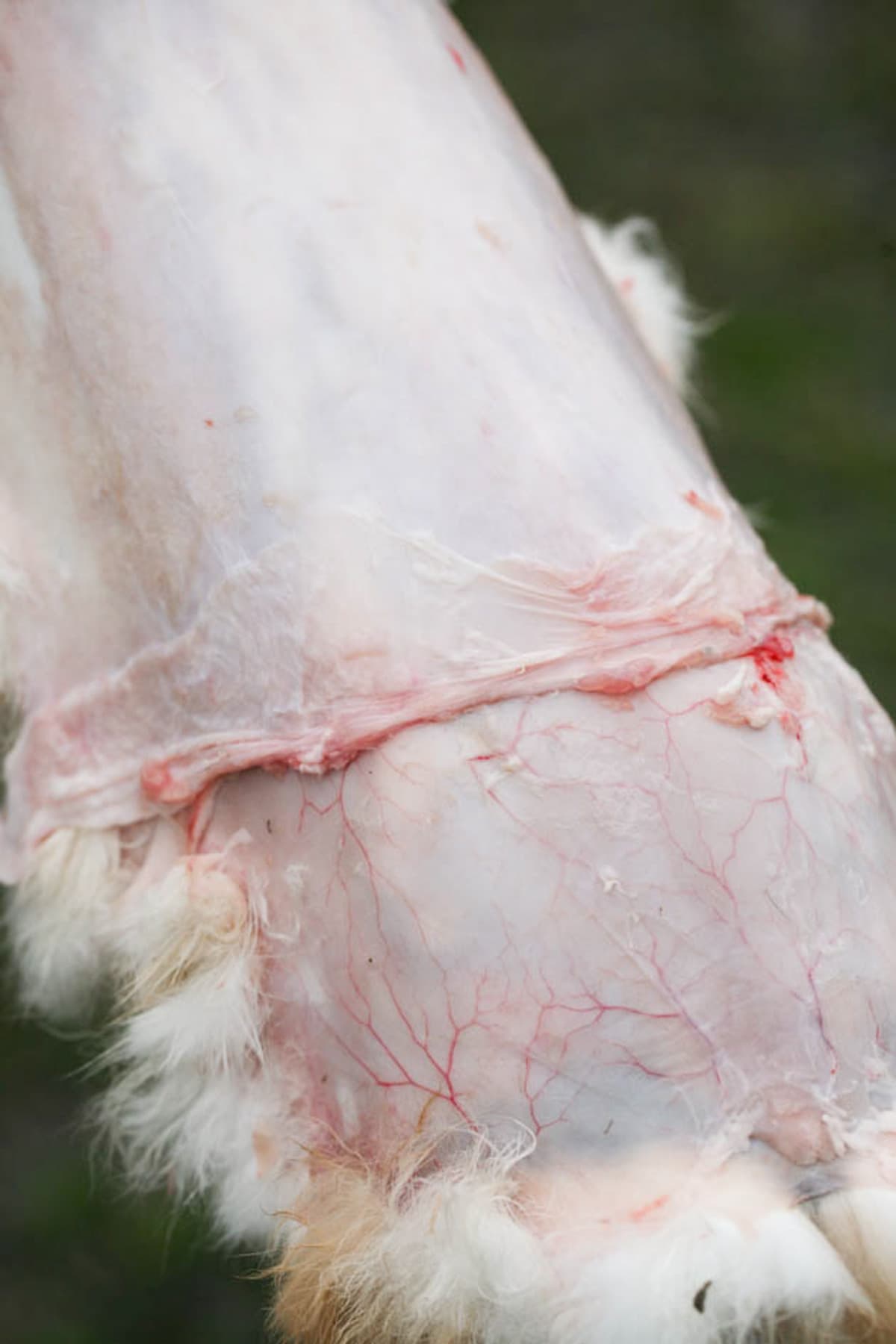
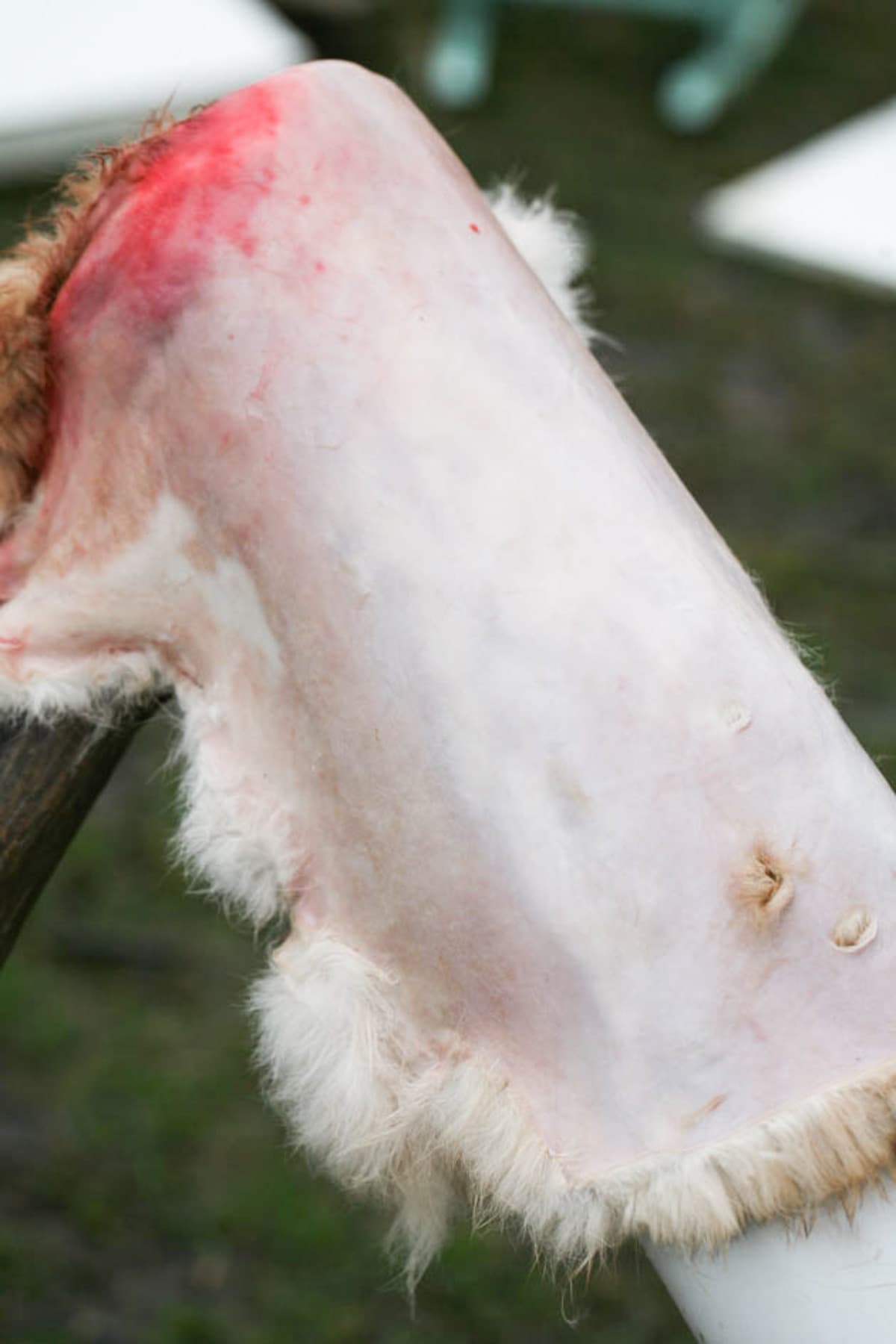
I’ve learned that this is so much easier with a deer hide! A deer hide is a hundred times tougher so you can just go at it, but rabbit skin is so thin and tears easily. In some areas, it’s as thin as paper. You have to do this gently or you’ll rip the hide.
If you do make holes in the hide it’s not a huge deal because we can always sew them later. But do go gently here and take your time. You might need to get rid of the hide that was around the front legs. You can cut it off which, of course, will leave you with two holes. Since they are close to the edge of the hide you can either trim around them or sew them later.
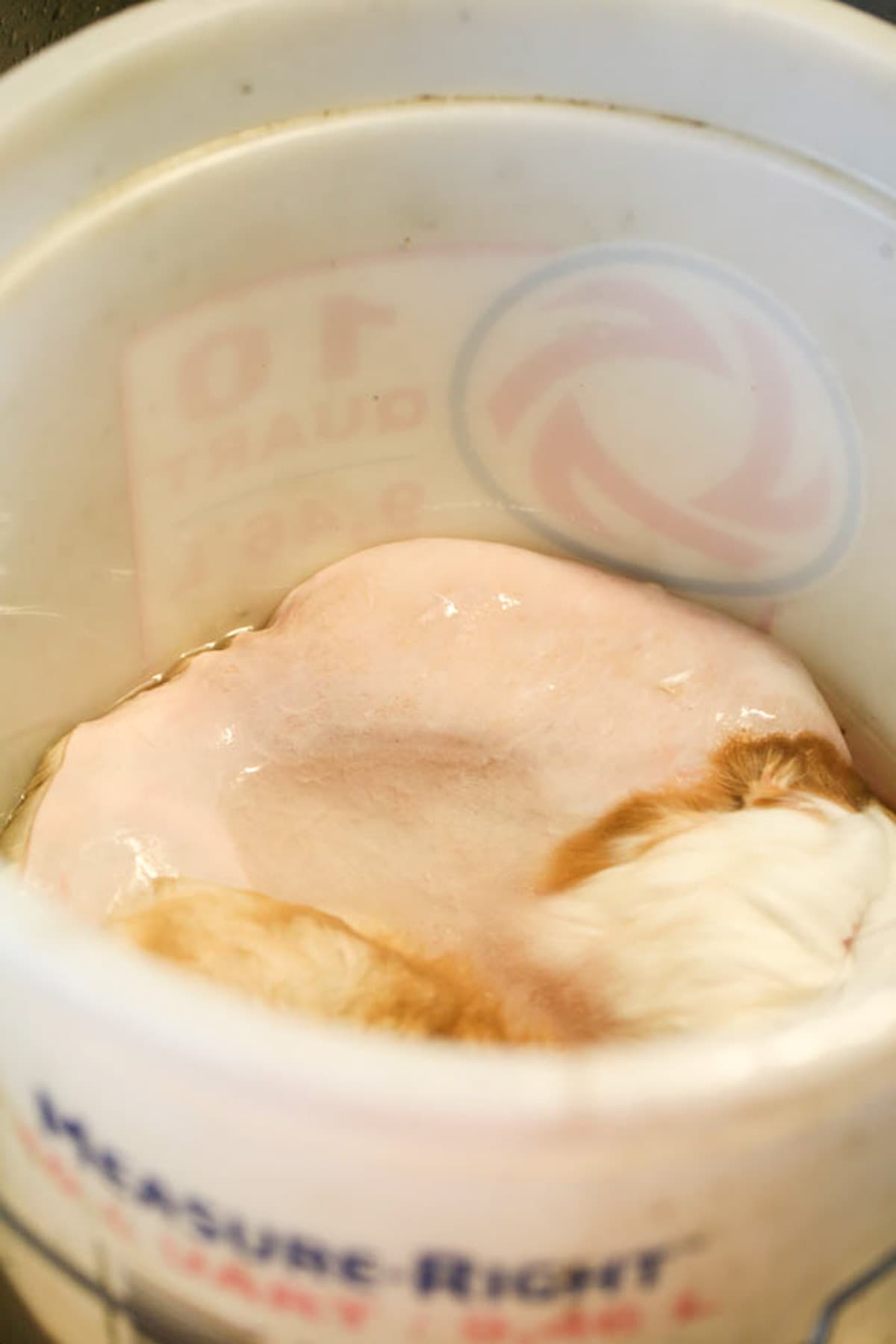
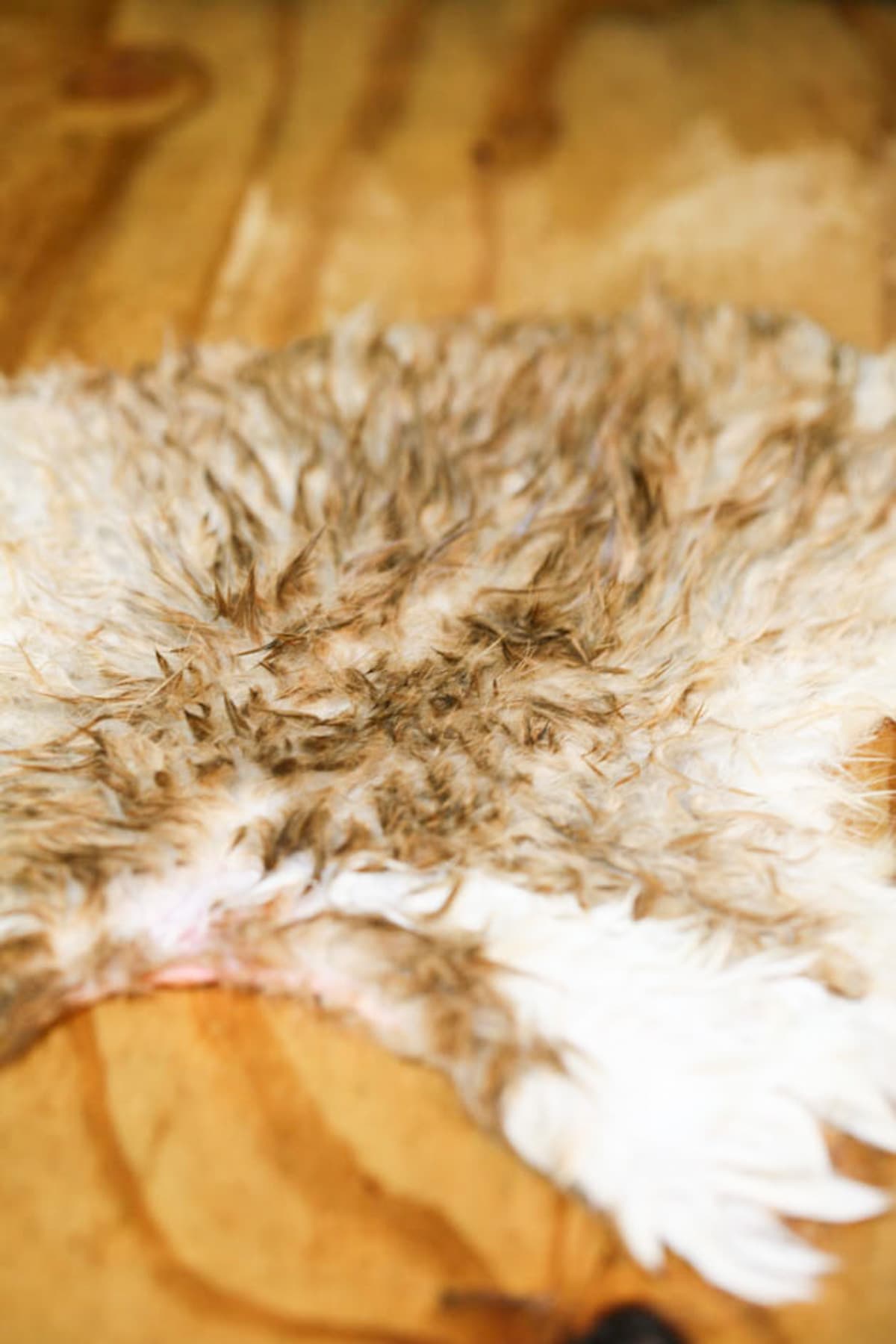
Step four – rinse the hide. After fleshing is done, it’s time to rinse again. This time, to get rid of some of the fat, put the hide in a bucket and use a tiny drop of dish soap and cold water. After you’re done rinsing the hide make sure to try and squeeze it and twist it as good as you can to remove as much water as possible.
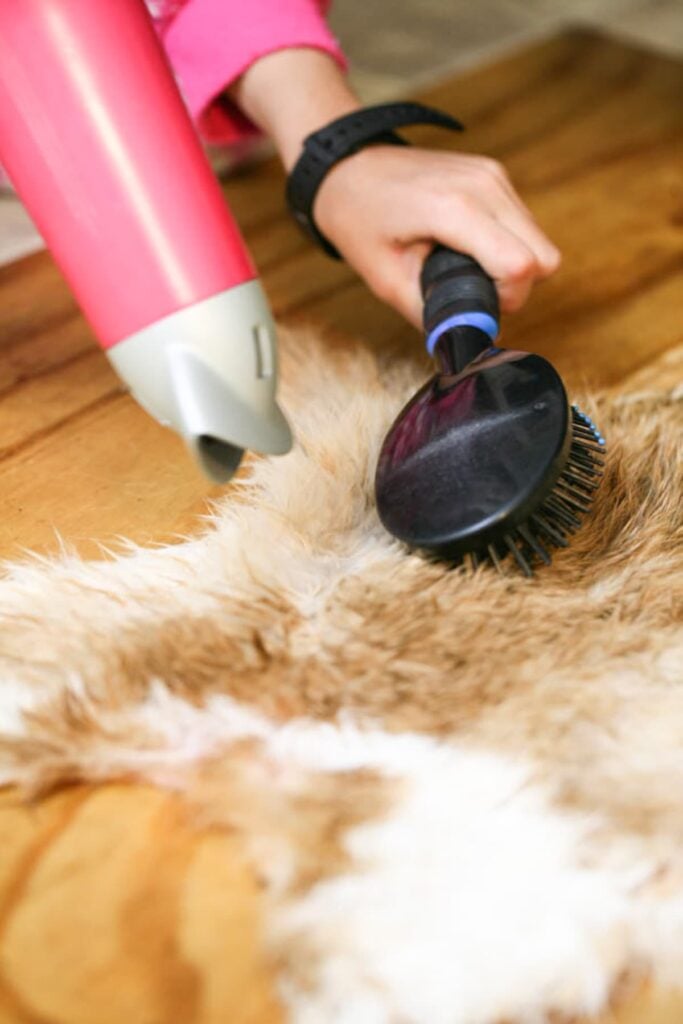
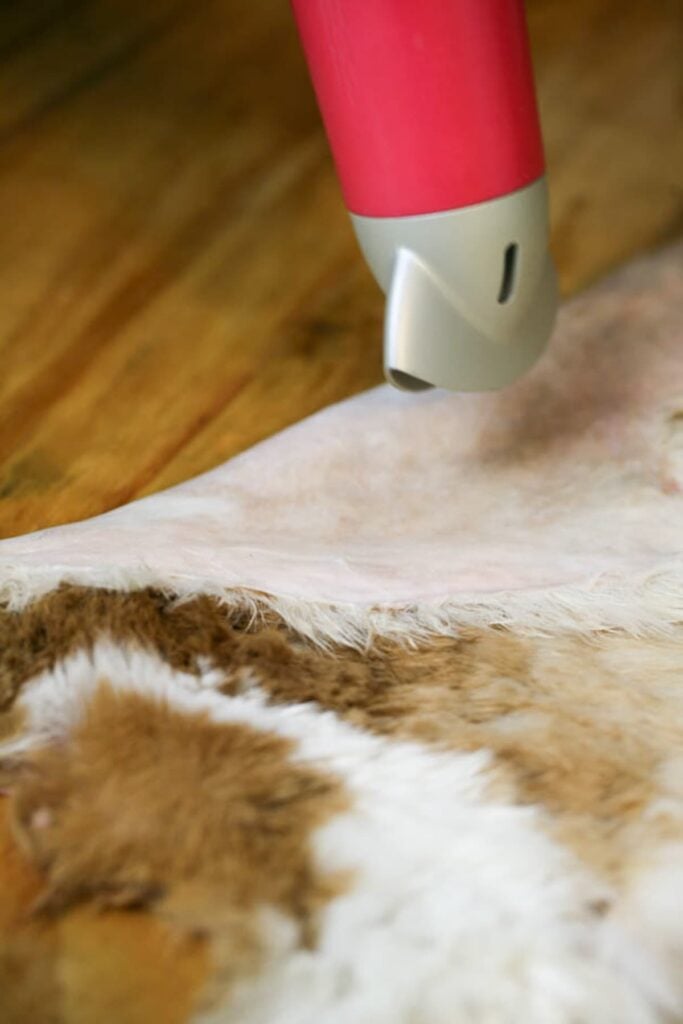
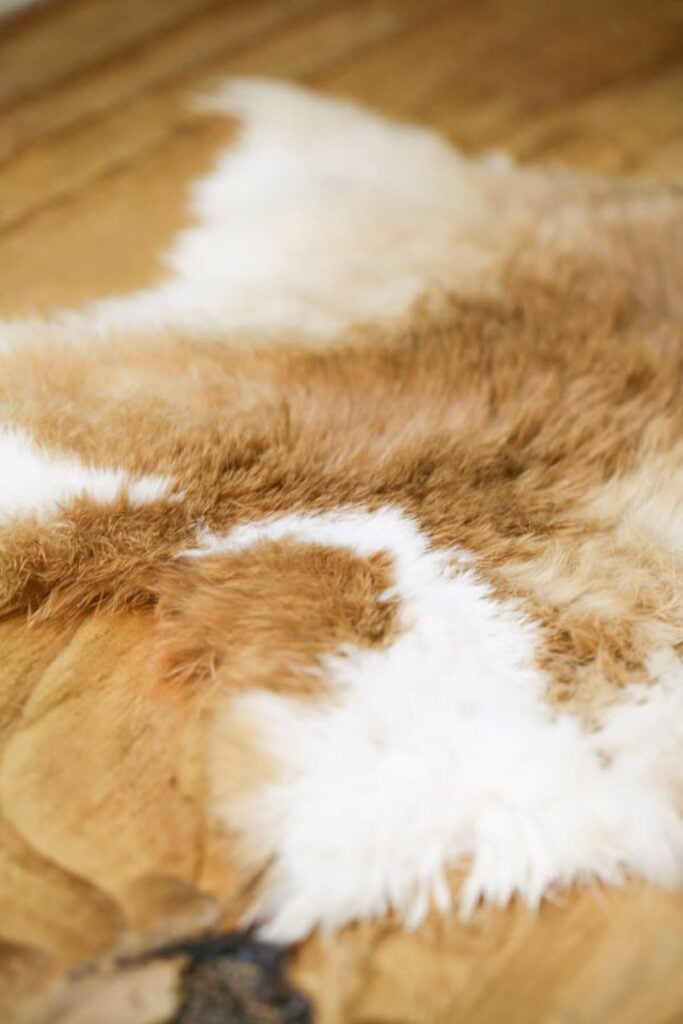
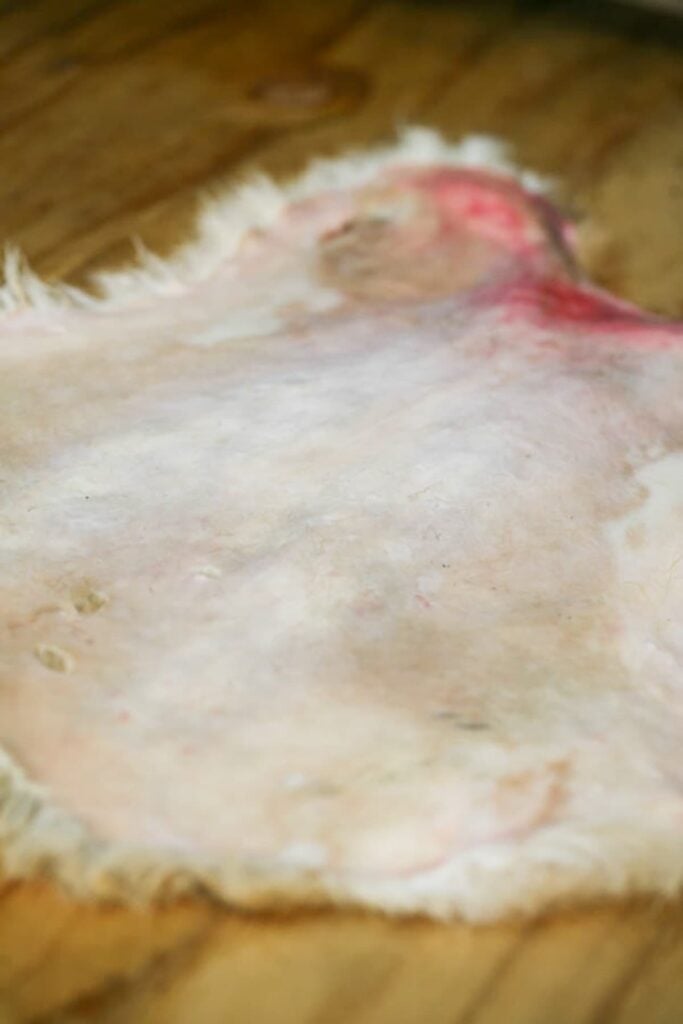
Step five – partially dry the hide. We are going to slightly dry the hide. The emphasis here is on SLIGHTLY, we want it just a tiny bit damp. Place the hide, skin down, on a piece of clean plywood, and use a hair dryer and a brush to dry the fur. This takes some time… We don’t need it completely dry, it’s going to go through another washing but we also don’t want the hide completely wet.
Of course, you don’t have to use a hairdryer. If it’s a nice day outside you can simply leave it in the sun and check on it once in a while. Make sure your dog can’t reach the hide and be mindful of flies, we don’t want them to come to lay eggs all over the hide.
Step six – pin the hide to a board. You can use whatever nails you have, they don’t have to be long nails like I used, It’s just what I had. Use your hammer and nails to pin the hide to the board to keep it stretched. You don’t need to stretch it tight, we just don’t want it to move. Keep the nails at the edge of the hide and don’t worry about the tiny holes that they make, they are barely noticeable.
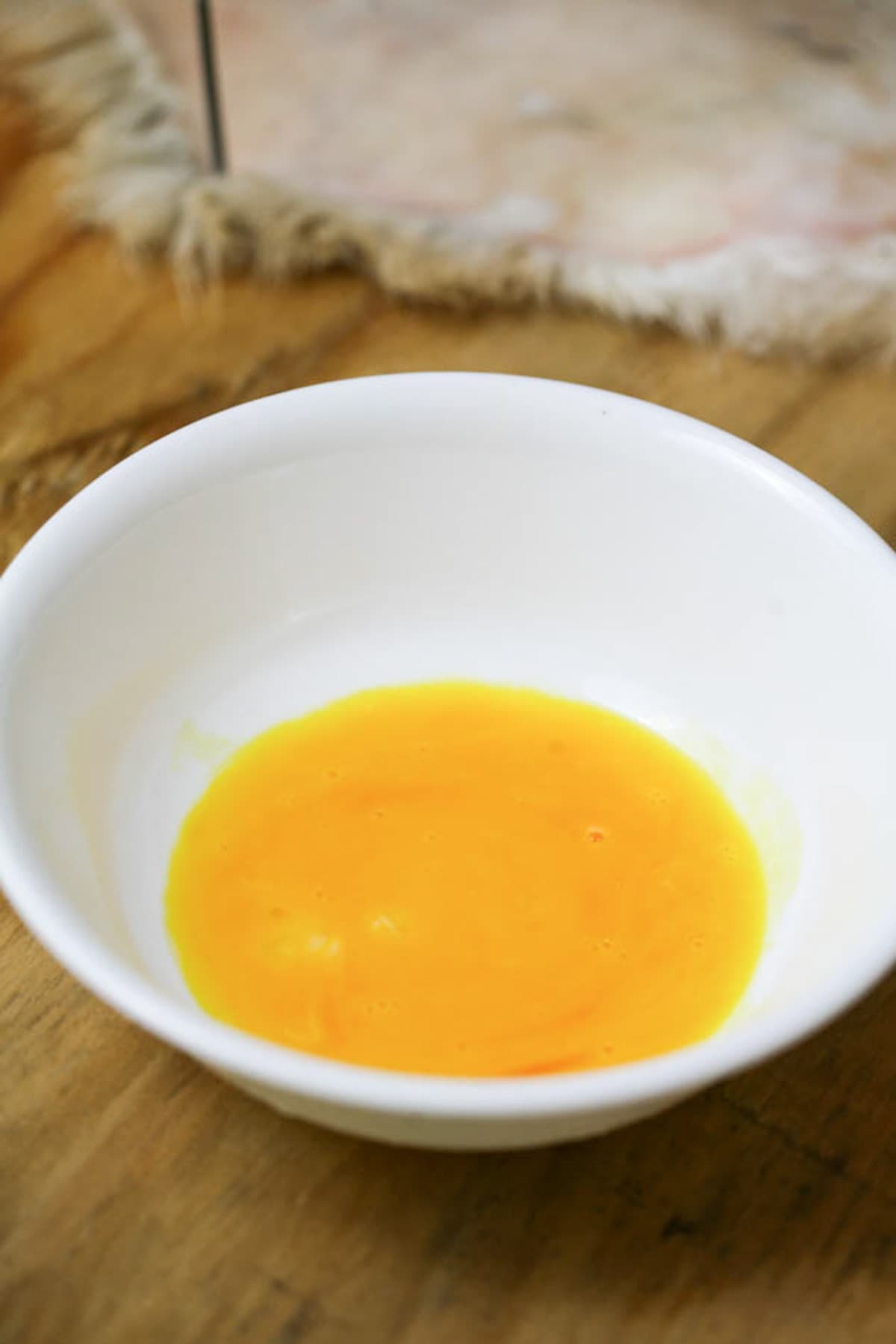
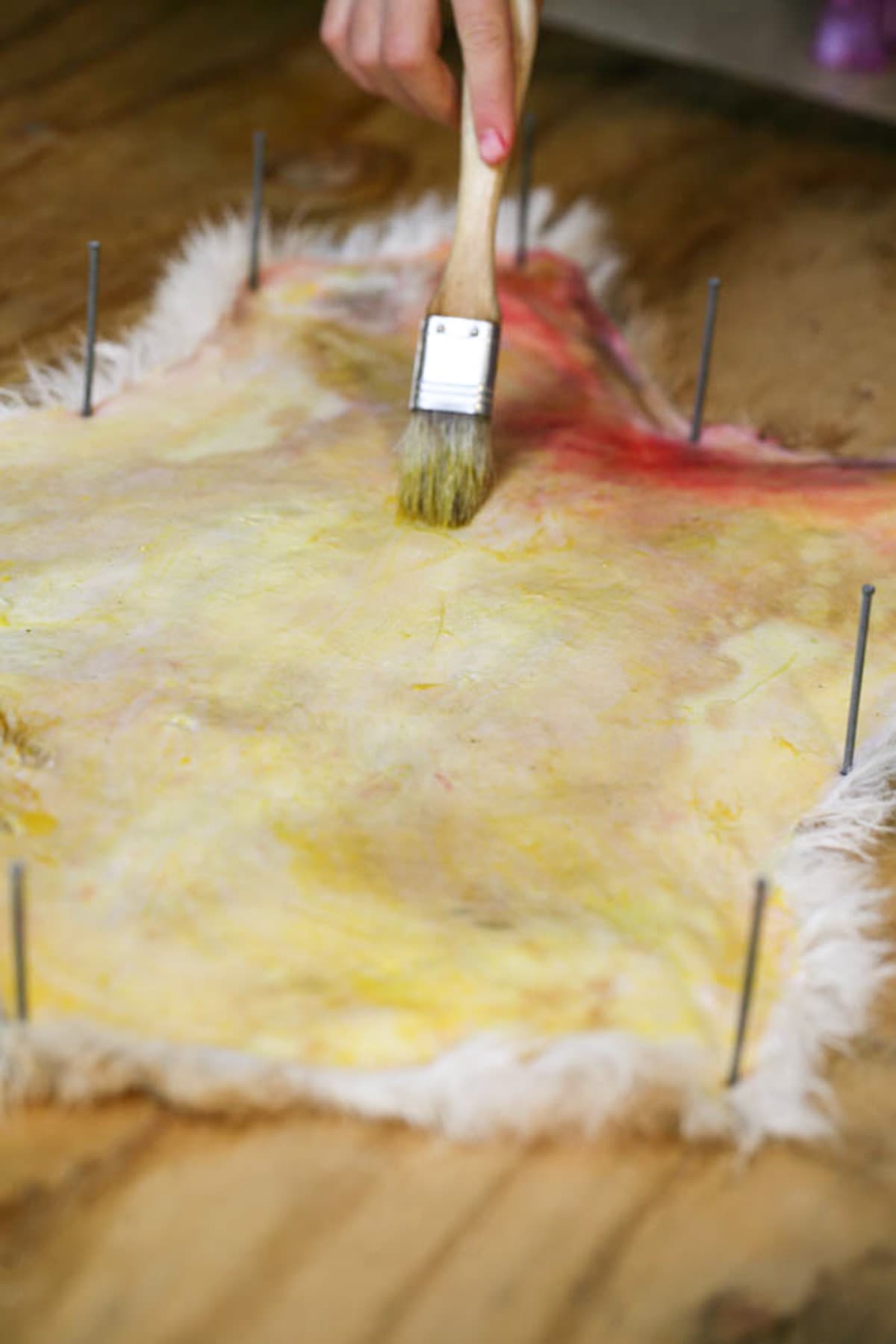
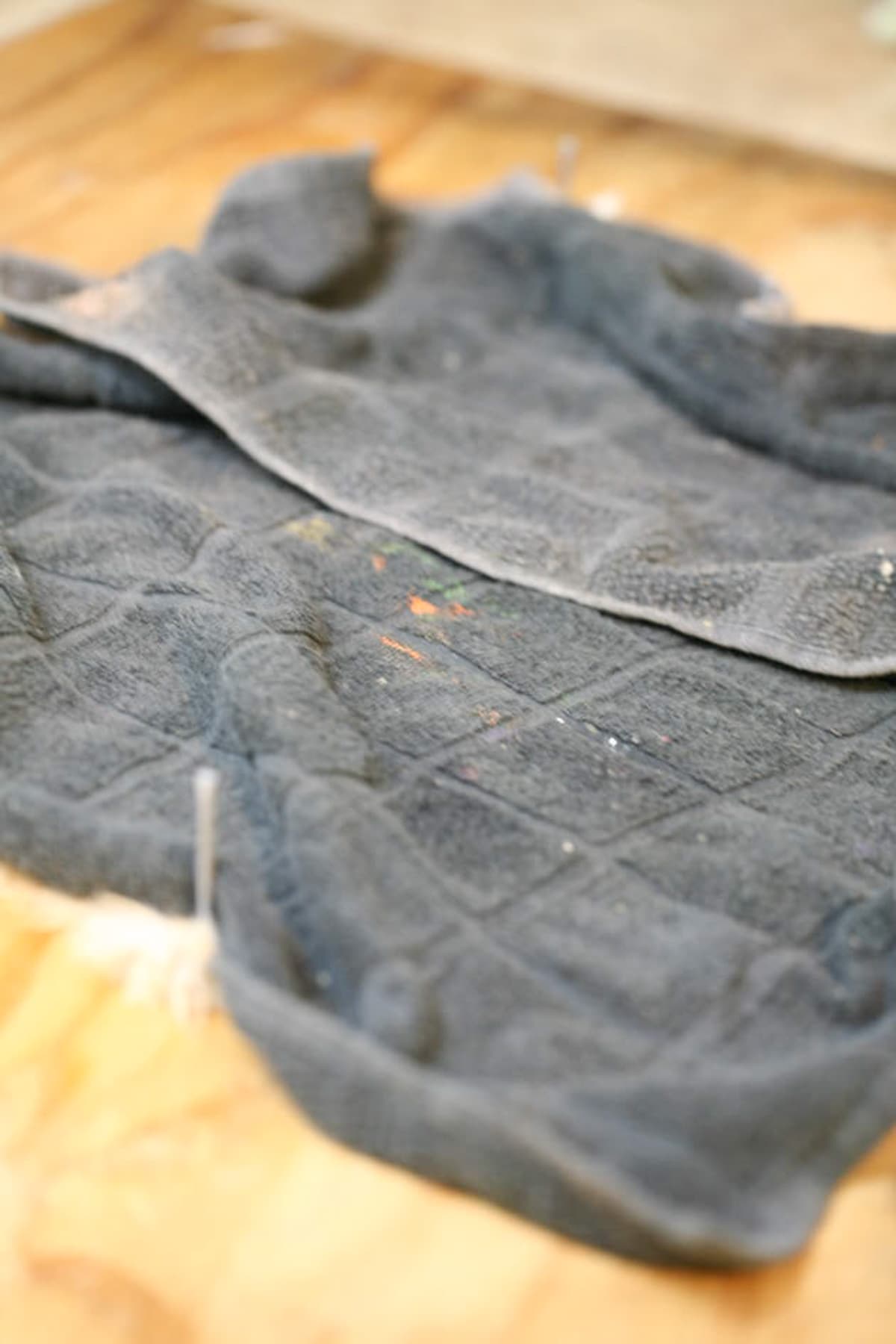
Step seven – brain the hide. Let’s talk about the braining process… Traditionally, you would use the brain of the animal to tan its hide. It is said that every animal has a brain big enough to tan its own hide (except a buffalo, I think). If you want to use the brain you can remove it from the animal’s head as I show you how to do with deer in my post How to Extract Deer Brain for Hide Tanning. I think that it works pretty much the same with all animals.
However, it’s really hard to do with small animals! It’s a tiny little brain and it’s so hard to get it out of the small skull. I tried, just for the sake of experimenting, and even though I got the brain out I found that it was really hard to dissolve it in water as you should do before spreading the solution on the hide.
So there are a couple of options here…
- Use a brain from another animal. If you have a deer brain in the freezer or if you can get pig or cow’s brain from the local butcher you can use that brain. Again, just dissolve it in a little bit of water and use the solution on the hide. If you want to see how to make the solution and for a recipe check out my How to Tan Deer Hide post.
- Use an egg yolk instead of the brain. That is what I ended up doing with this hide…
All you need is one egg yolk, it has a lot of fat in it and will help us soften the skin. Beat the yolk in a bowl and use a kitchen brush to brush the damp skin. Make sure to cover every area of the skin with a good amount of egg yolk (one egg yolk should be enough for one rabbit hide). Try not to brush the fur with the egg yolk but if you do it’s no big deal.
Then, cover your hide with a damp towel. Leave it like that for the night and make sure the hide does not dry. So if you leave it in a warm place keep your towel a bit damp to keep the moisture. If you leave the hide outside or in a shed, make sure to cover it well so flies don’t lay eggs on it.
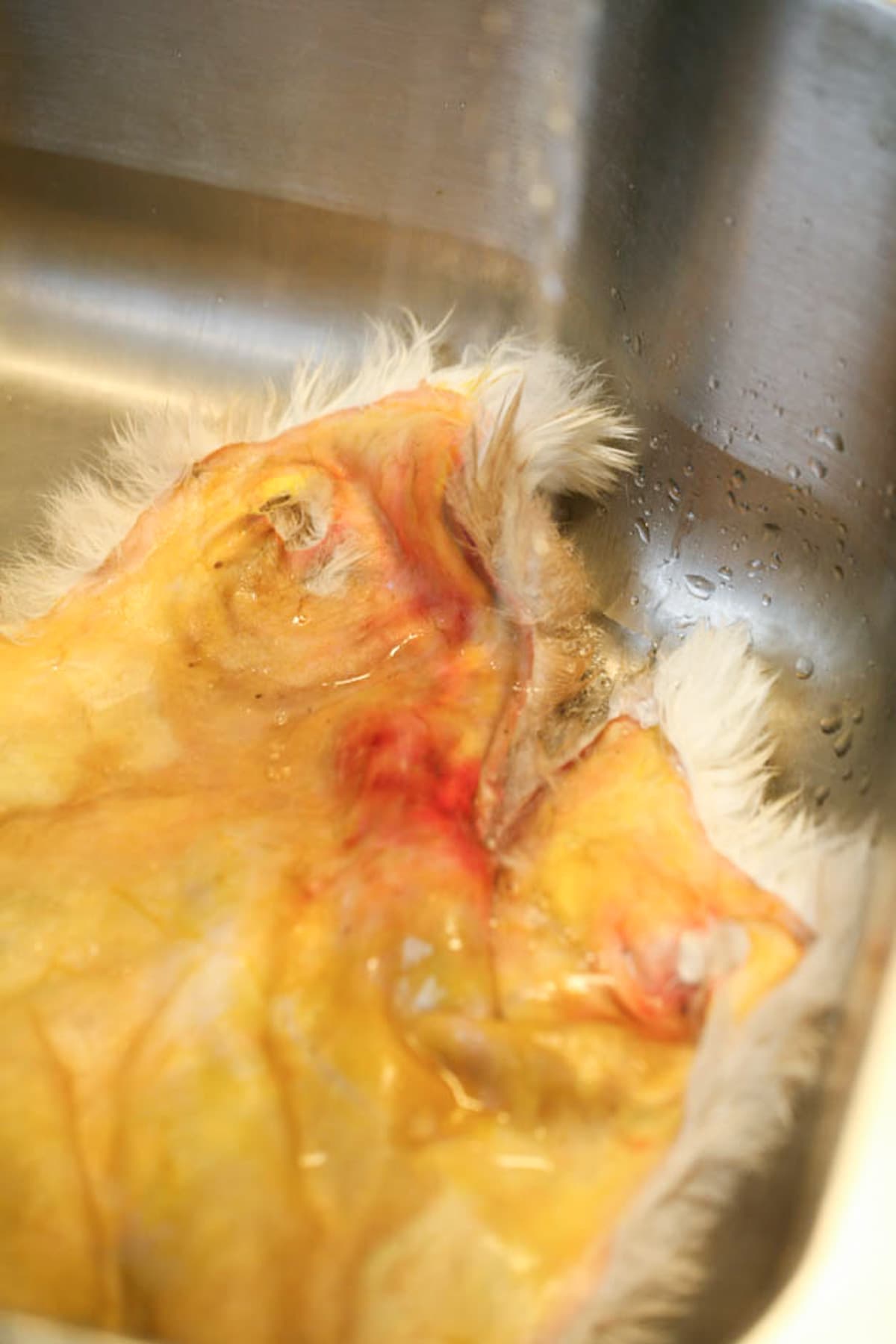

Step eight – third rinse. Next, let’s wash the egg yolk from the hide. Again, only use water in this step, no soap and then squeeze the hide well to remove the excess water.
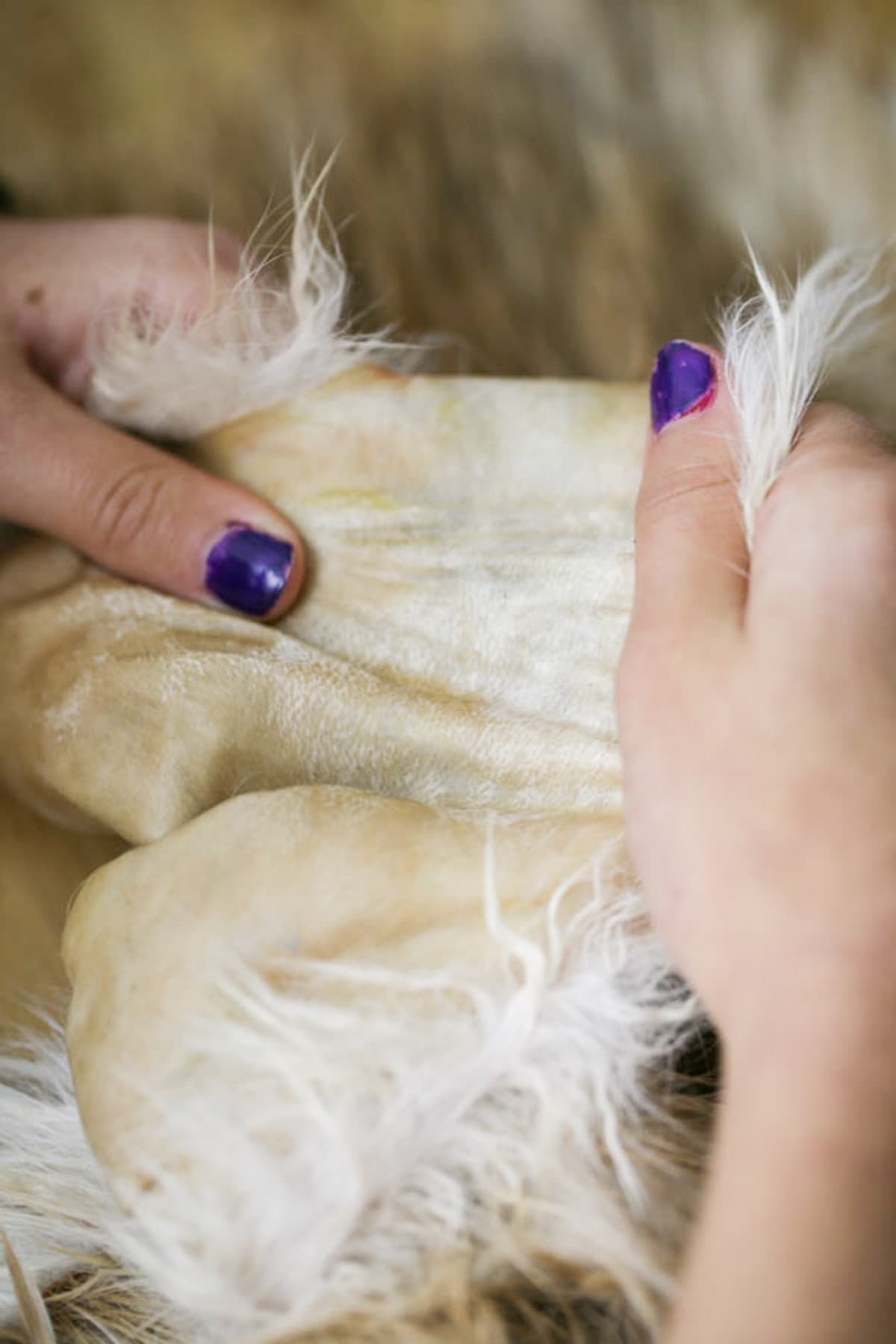
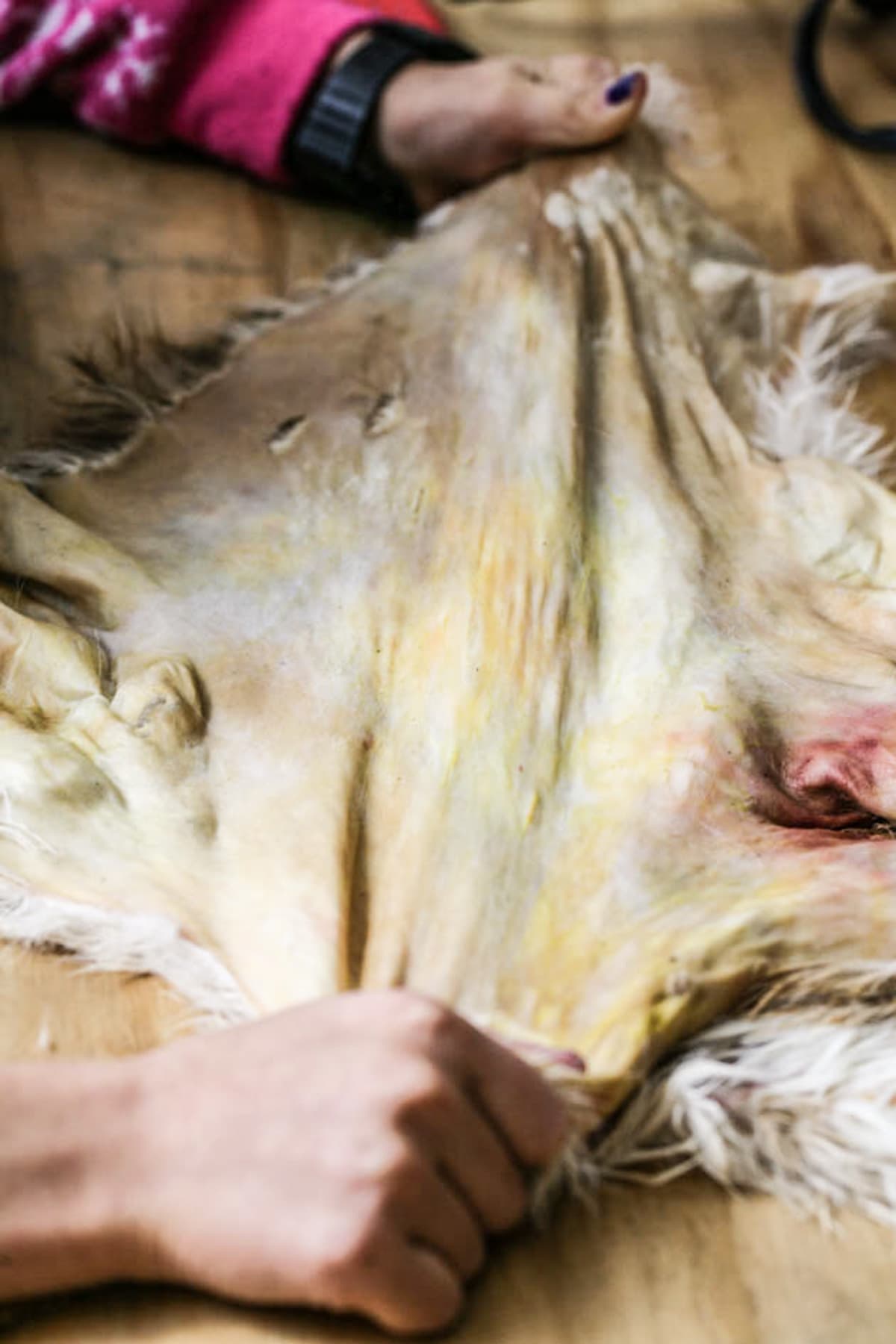
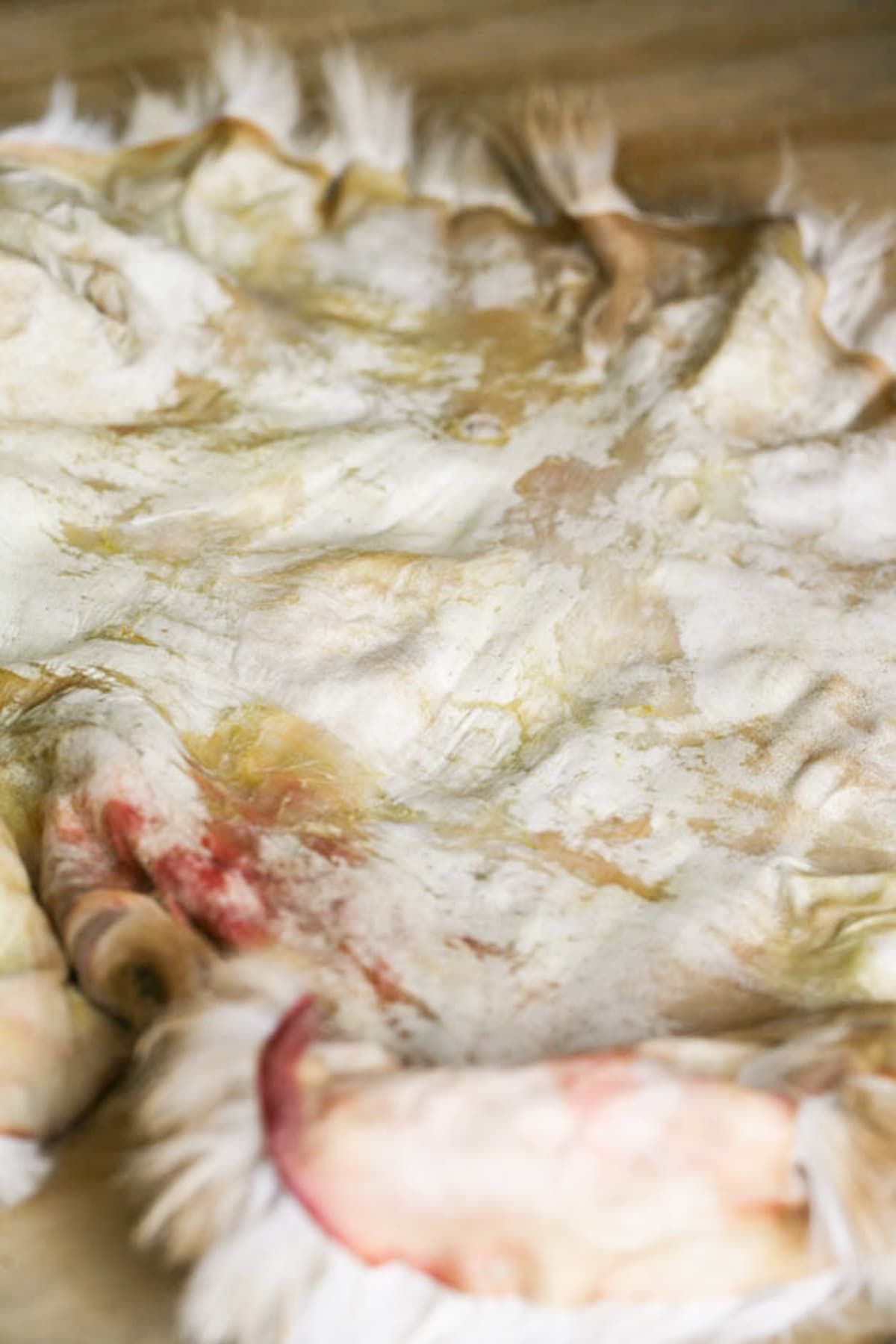

Step nine – dry and soften the hide. You are almost done! Now, the softening part is the hardest with a deer hide because the skin is so thick but the easiest part to do with a rabbit hide because the skin is so thin. You need to be gentle here since you can easily rip the skin if you pull too hard.
Alternate between drying, stretching, and pulling the skin. You can use the hairdryer again a little bit at the beginning to get to a point where the hide is damp, then pull and stretch a little bit. Let the hide sit on the board to dry in the air a little bit longer, then work the hide again for a few more minutes.
Pull here, pull there, stretch it this way and that way. The point is to do this as the skin is drying. If you let it sit and dry too much it will just dry hard and we don’t want that. As the skin dries and you pull it to open it up and soften it, you’ll notice that it changes color a little bit, and everywhere that you soften and is getting close to being completely dry becomes whitish (that’s an indication that you are doing it right).
Some people do this for a couple of hours in front of the TV at night, I preferred doing it over a period of three days. I mess with the hide for a few minutes, then fold it in half skin to skin and again fur to fur and place it in a plastic bag. This way it doesn’t dry on me too quickly.
I went back to it after a few hours for another 15 minutes of stretching and softening and then folded it and put it in the bag again and so on and so on until it was completely dry. This just worked better for me but you can do it all in a couple of hours if you prefer.
I do need to warn you that some hair does come off and can make quite the mess. So wear clothes that you don’t mind getting rabbit fur on and prepare to clean your house from rabbit hair if you do this indoors.As the hide is drying, this is also your time to sew any holes if you want to. I’ve heard of people just using a regular needle and thread because the skin of a rabbit is so thin, but if you want you can use leather sewing equipment.
Step ten – smoke the hide. The last step in the hide tanning process is to smoke the hide. If you don’t smoke and leave it at this stage, every time it touches water it will go back to being raw hide. The smoke preserves the skin, closes it, and makes it waterproof.
I haven’t smoked my hide yet. I am in the process of building a smoker so it’s easier for me to smoke hides (and other things). You can see the smoking process in the deer hide tanning post that I linked to above but since rabbit hide is smaller and thinner you should only smoke it for around 30 minutes.
Once your hide is smoked, leave it outside in the fresh air to lose the smoke smell, then, you can use it in projects. You’ll probably need more than one hide for a project. Another option is to use it as part of a project. For example, I was thinking about sewing a purse from my deerskin and adding pieces of rabbit fur here and there.
Caring for a Tanned Rabbit Hide…
As far as I know, there isn’t much that you’re supposed to do after smoking the hide. You might want to give the fur a brush once in a while, but other than that, there is really not much to maintain.
Tips…
- Getting the hide – if you want to try this but don’t raise rabbits for meat, try to find someone in your area who does or someone who hunts rabbits. A good place to ask is in your local Facebook homesteading groups.
- Place the hide in the freezer – when you do get a rabbit or just the rabbit hide, if you don’t have time to work it right away, fold it, place it in a ziplock bag, and place it in the freezer. When you have time, take it out and let it thaw before starting the tanning process.
- Freeze deer brain – during the hunting season, if you can extract deer brain and place it in the freezer (each brain in its own ziplock bag), do so. I think that brain mixed with water is a better solution than the egg. It’s very fatty and softens the skin much more.
- Other animals – follow this hair-on tanning process with any other small animal. I’ve tried a raccoon, a young goat that didn’t make it, a groundhog… It can be the same process with all the other small animals.
- Use a net – if you are planning to leave the hide to dry outside, it might be beneficial to place it under a net of some sort. Flies find it very quickly and we do want to try to keep them away.
- Vacuum – another thing that can make this process a bit easier is a vacuum. Especially if you are going to work the hide inside. It does lose some hair and it can be much easier to clean the mess with a vacuum.
Frequently Asked Questions…
Some say it is and therefore it’s harder to tan a wild rabbit hide. It seems to tear easily.
After smoking the hide, let it hang outside in fresh air for a couple of days. You can also try to wash the hide with a drop of dish soap. Another option is to mix a few drops of lemon essential oil with water in a spray bottle and spray the hide.
At any point, rinse it and start the process again. You can do it over and over as many times as you need.
In order to prevent what we call “slipping”, try to work the hide as soon as possible. Slipping is generally caused by bacteria getting into the skin. If you can, work the skin right after you skin the animal. If you freeze the skin, make sure to thaw it slowly in a warm place, preferably in the sun so it “dry thaw”.
I hope that this tutorial on how to tan a rabbit hide gave you an idea of the process. Again, follow the principals but you can try changing the methods a bit to fit your schedule or the way you like to work. If you grow rabbits for meat, this is a great way to use their skin. This is also a great project for a child who wants to start with hide tanning since the skin is thin and is not too hard to work. I hope that you’ll try tanning a rabbit hide!
More Great Tutorials…
- How to Cook a Rabbit
- How to Weave a Round Basket
- Fishing Line Deer Fence
- How to Make Goat Milk Soap
- How to Make a Bamboo Screen

How to Tan a Rabbit Hide
How to tan a rabbit hide (fur-on) with an egg yolk.
Materials
- One rabbit hide
Tools
- Sharp skinning knife
- Fleshing knife
- Work beam
- Gloves
- Vinyl apron
- Dish soap
- Plywood
- Hair dryer
- Hair brush
- Nails
- Hammer
- Egg yolk
- Bowl (for the egg yolk)
- Kitchen brush
- Towel
Instructions
- Skin the rabbit: hang the animal from its back legs, cut the skin right under the back legs joint, and then continue in a V shape towards the center of the tummy, between the two hind legs.
From there you move in a straight line down the stomach until you get to the neck. Cut the head off and you are left with the hide. - Rinse the hide: no soap, just cold water will do.
- Flesh the hide: place the hide, fur down, on a beam and gently scrape the flesh off the skin. You have to do this gently or you'll rip the hide. If you do make holes in the hide it's not a huge deal because we can always sew them later. But do go gently here and take your time.
- Rinse the hide: after fleshing is done, it's time to rinse again. This time in order to get rid of some of the fat, I put the hide in a bucket and used a tiny drop of dish soap and cold water.
After you're done rinsing the hide make sure to try and squeeze it and twist it as good as you can to remove as much water as possible. - Partially dry the hide: we are going to slightly dry the hide. The emphasis here is on PARTIALLY, we want it just a tiny bit damp. Place the hide, skin down on a piece of clean plywood and use a hair dryer and a brush to dry the fur.
- Pin the hide to a board: set the hide on a plywood board, fur to the board, and use a hammer to hammer nails around to hold the hide to the board. You don’t need to stretch it. We just want to make sure that it is held in place.
- Brain the skin: if you have a deer brain or a pig brain that you can use, feel free to use it (the recipe for a brain solution for hide tanning can be found in my post How to Tan a Deer Hide). The other option is to add one egg yolk to a bowl and beat it. Then use a kitchen brush to brush the skin with it.
When you are done, cover the hide with a damp towel and leave it covered overnight. - Rinse the hide: in the morning, rinse the hide again with cold water to remove the egg yolk (don't use soap).
Squeeze the hide well to remove the excess water. Try to remove as much water as you can by squeezing it and twisting it. - Dry and soften the skin: alternate between drying (you can use the hair dryer) and stretching and pulling the skin. I used the hairdryer a little bit at the beginning to get to a point where the hide was damp, then pulled and stretched a little bit. Be careful not to rip the skin.
We pull here, we pull there, we stretch it this way and that way. The point is to do this while the skin is drying. If you let it sit and dry too much it will just dry hard on you and we don't want that.
As the hide is drying, this is also your time to sew any holes if you want to. - Smoke the hide: to make the hide waterproof, you are going to have to smoke it. Smoke the hide in a smoker or above a smoking fire pit for 30 minutes.
Notes
Frequently Asked Questions...
- Is wild rabbit skin thinner than farm-raised rabbit?
Some say it is and therefore it’s harder to tan a wild rabbit hide. It seems to tear easily. - How can I get rid of the smoke smell?
After smoking the hide, let it hang outside in fresh air for a couple of days. You can also try to wash the hide with a drop of dish soap. Another option is to mix a few drops of lemon essential oil with water in a spray bottle and spray the hide. - Somewhere along the way, my hide dried and is now hard. What should I do?
At any point, rinse it and start the process again. You can do it over and over as many times as you need. - The hair is slipping off the skin! What can I do?
In order to prevent what we call “slipping”, try to work the hide as soon as possible. Slipping is generally caused by bacteria getting into the skin. If you can, work the skin right after you skin the animal. If you freeze the skin, make sure to thaw it slowly in a warm place, preferably in the sun so it “dry thaw”.
Recommended Products
As an Amazon Associate and member of other affiliate programs, I earn from qualifying purchases (there is no change in product cost or charge to you! Thank you for helping me support the blog).
-
 Remington D3190 Damage Protection Hair Dryer with Ceramic + Ionic + Tourmaline Technology, Purple
Remington D3190 Damage Protection Hair Dryer with Ceramic + Ionic + Tourmaline Technology, Purple -
 Aulett Home Waterproof Rubber Vinyl Apron - 40" Heavy Duty Model - Best for Staying Dry When Dishwashing, Lab Work, Butcher, Dog Grooming, Cleaning Fish - Industrial Chemical Resistant Plastic
Aulett Home Waterproof Rubber Vinyl Apron - 40" Heavy Duty Model - Best for Staying Dry When Dishwashing, Lab Work, Butcher, Dog Grooming, Cleaning Fish - Industrial Chemical Resistant Plastic -
 Freedom Brand Standard Fleshing Knives (10")
Freedom Brand Standard Fleshing Knives (10") -
 SIMPZIA 20 Pieces Leather Craft Tools with Hand Sewing Needles Drilling Awl Waxed Thread and Thimble for Leather Upholstery Carpet Canvas DIY Sewing
SIMPZIA 20 Pieces Leather Craft Tools with Hand Sewing Needles Drilling Awl Waxed Thread and Thimble for Leather Upholstery Carpet Canvas DIY Sewing

Hi! I’m Lady Lee. I help homesteaders simplify their homesteading journey while still producing a ton of food! I am a single mother of four, I was born in Israel and raised in an agricultural commune called a Kibbutz. Now I homestead in central NC.

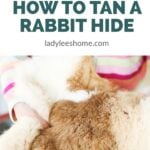
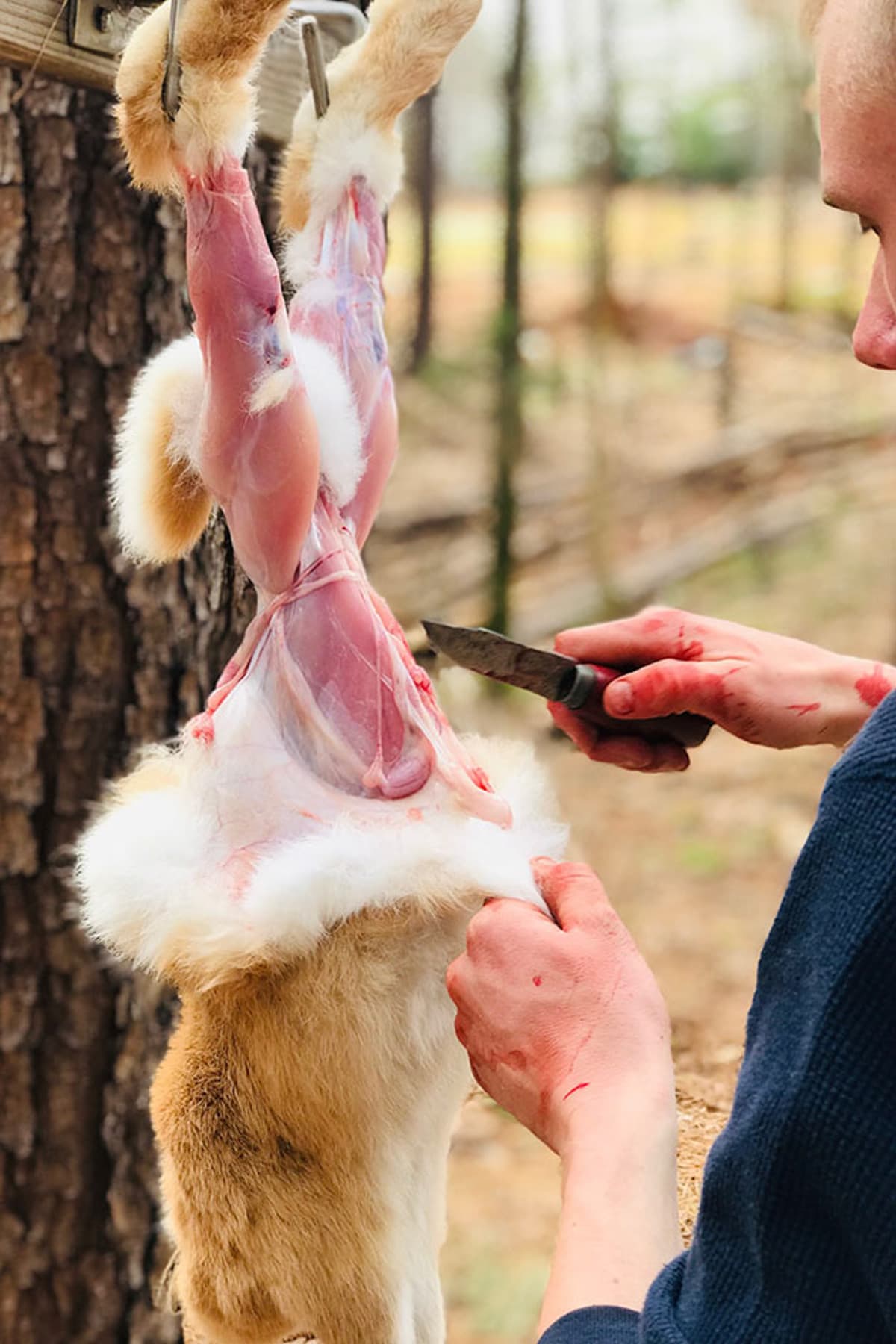
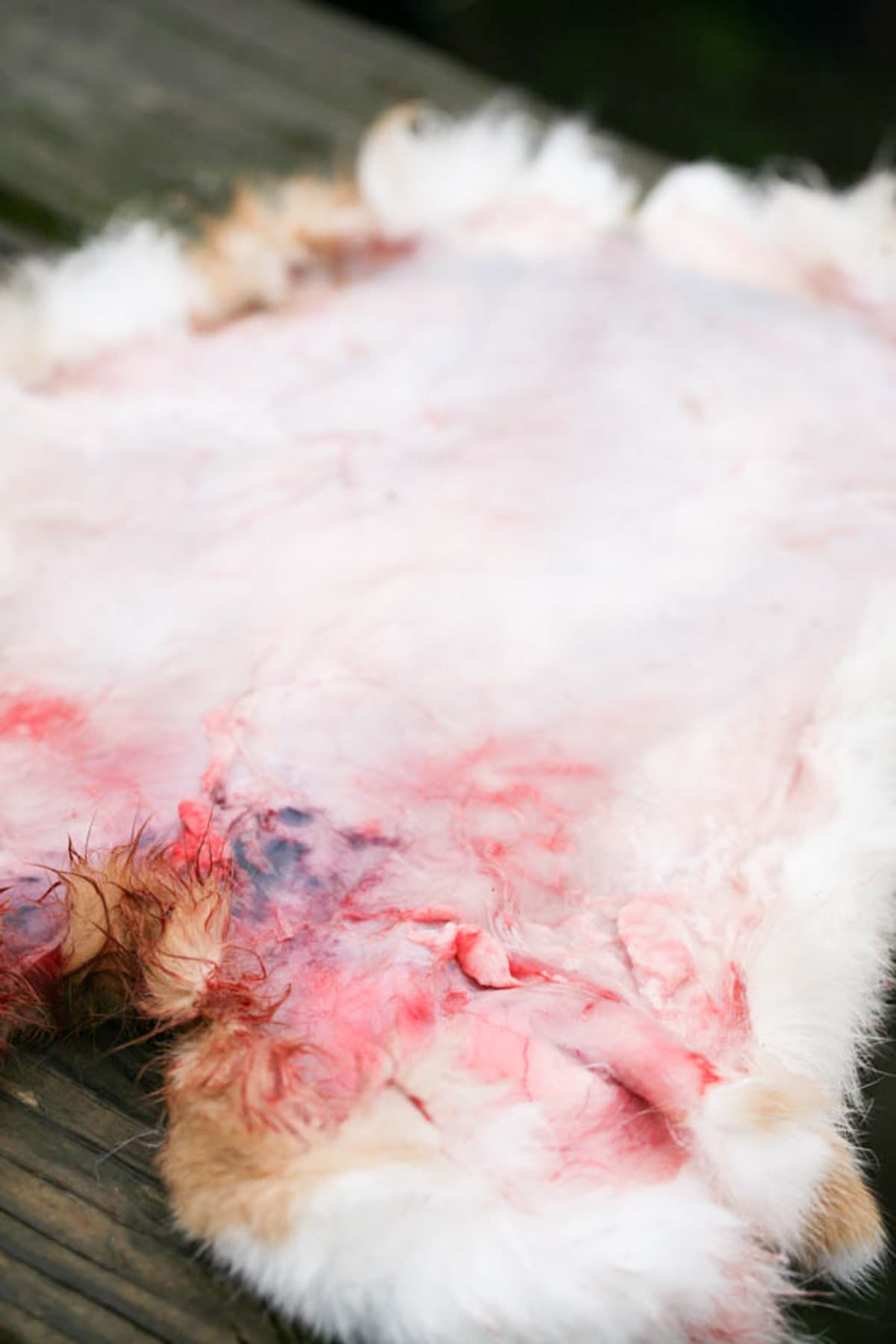
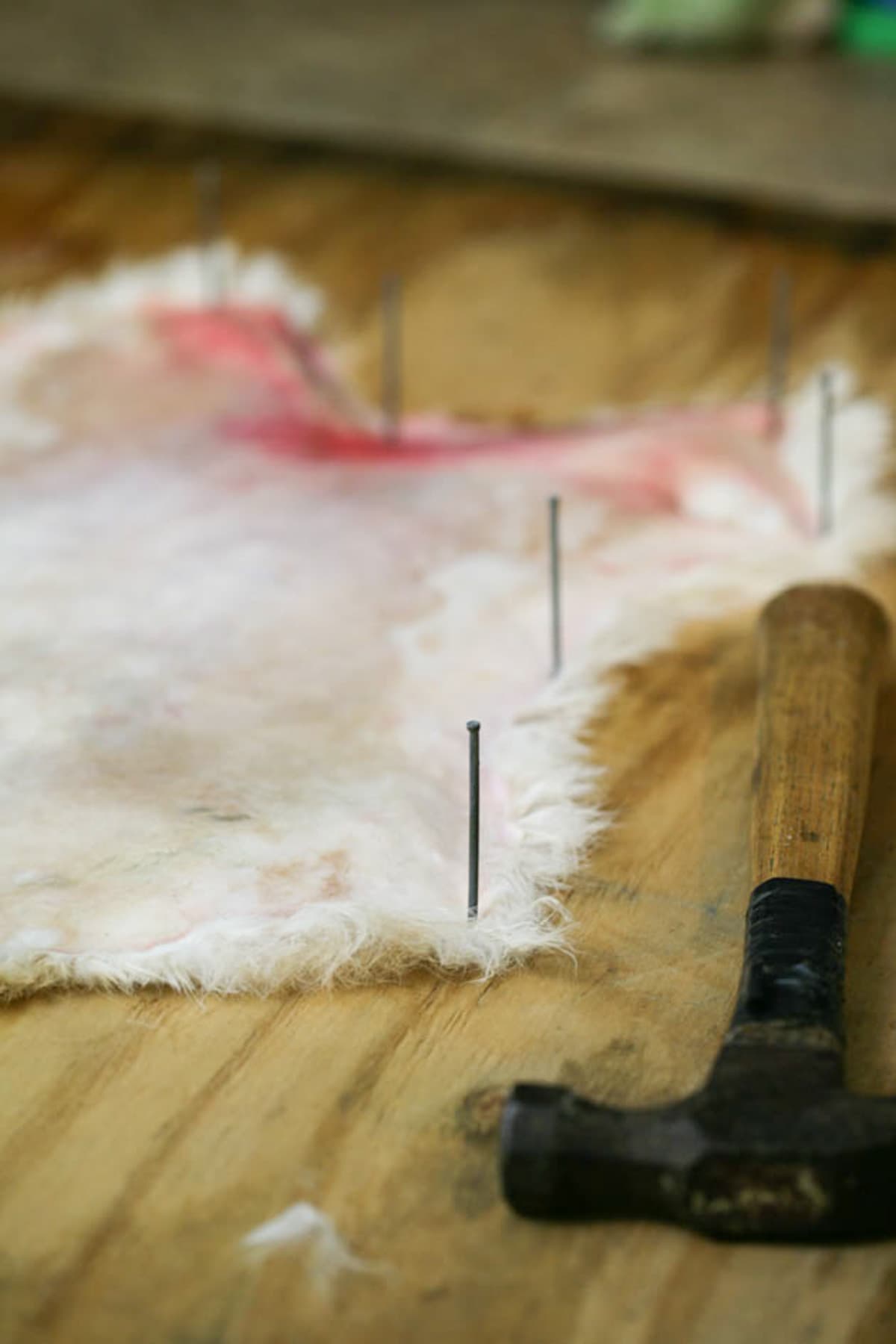





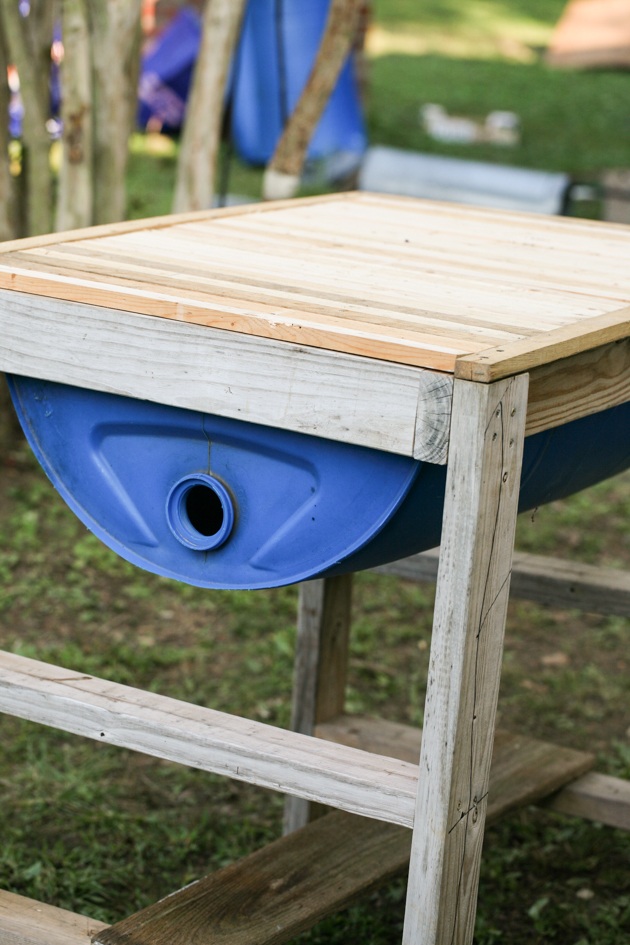

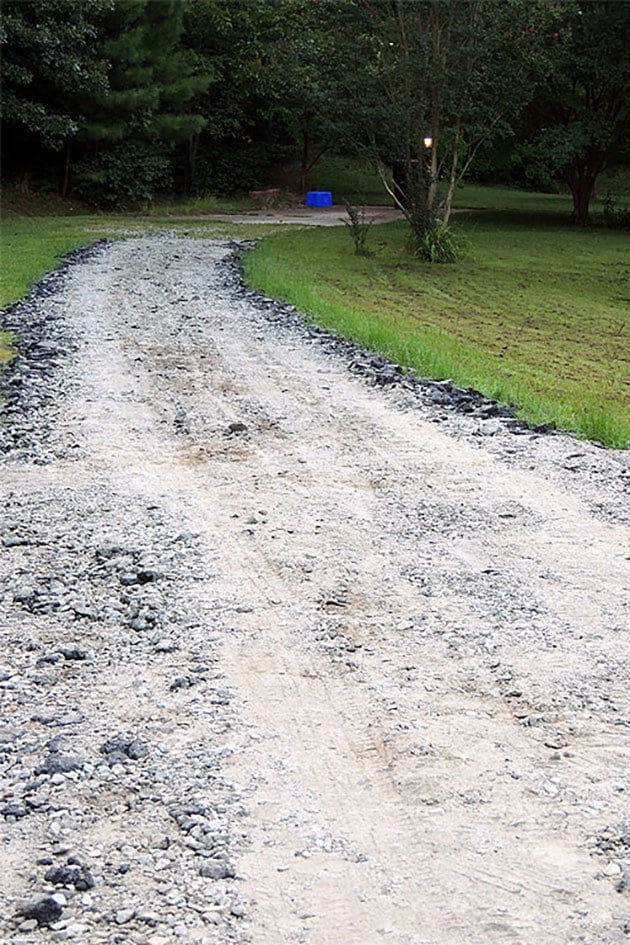
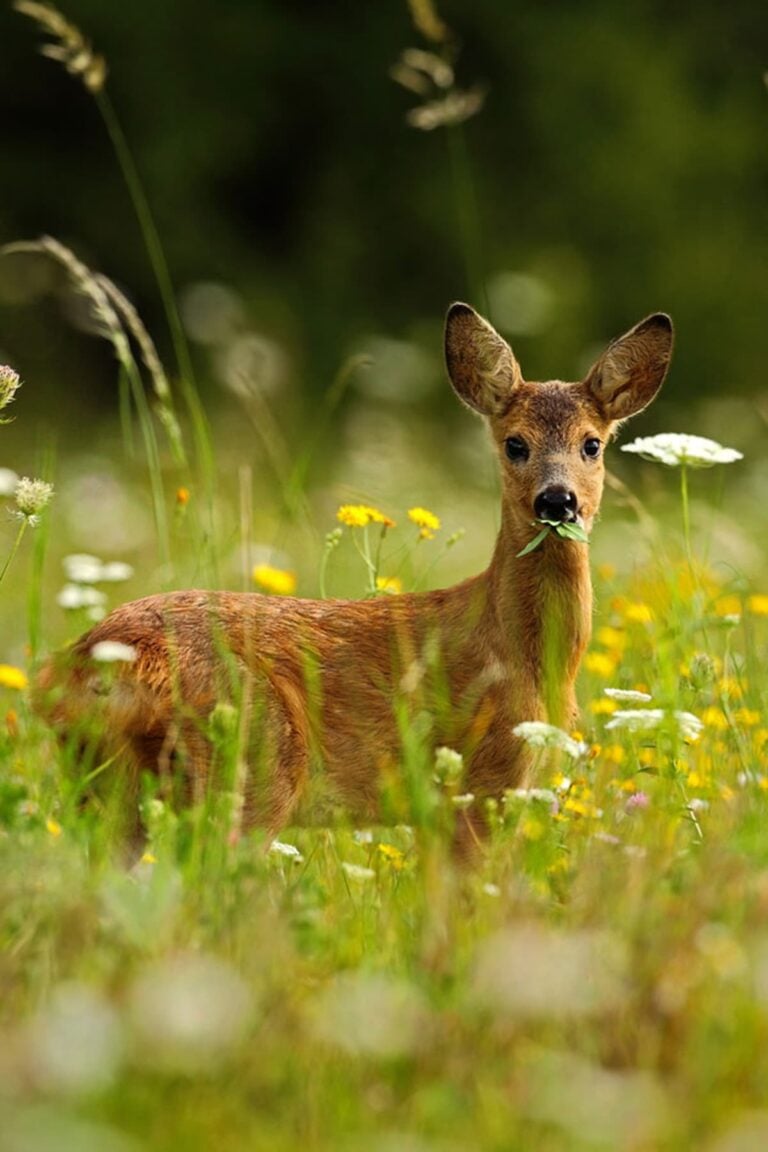

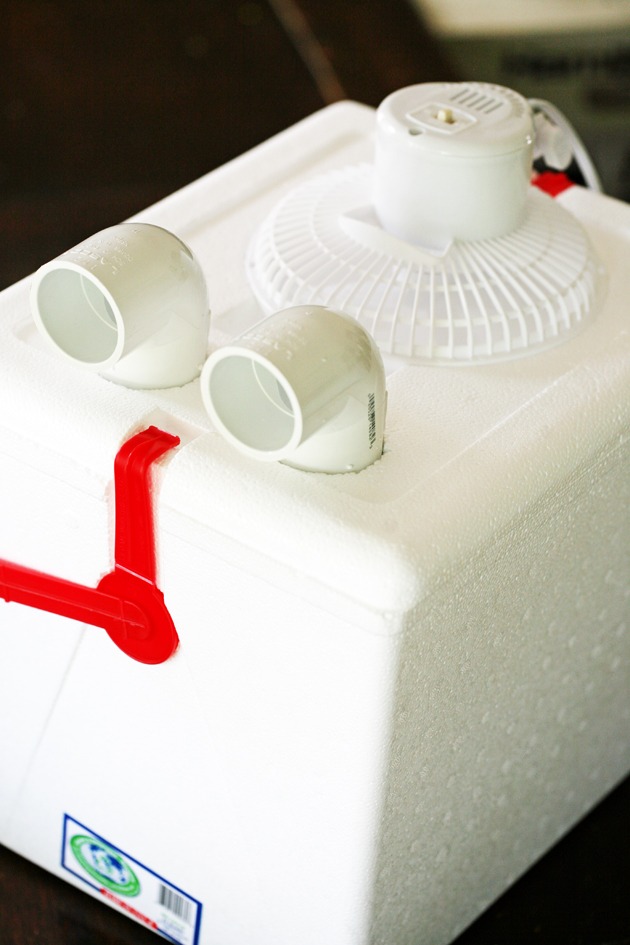
I feel your pain. I have started snaring rabbits for food and I wanted to an the hide also. I googled it and used a system like yours. Like you I ripped holes in the hide. Trashed the first hide so bad I threw it away. I think wild rabbit have the thinner hides than farm rabbits. I could not stretch them like they do in the videos on You tube. I am going to try a farm rabbit from a guy down the road and see if the hide is a bite thicker. In your trials have you found wild rabbits to have thin hides and not much to flesh off?
Thanks for the information.
Mary in Ohio
I haven’t tried tanning wild rabbit hide before, however, we skinned one last week and the skin ripped completely, there was nothing to tan! We weren’t too careful but still, it was really thin so I think that you might be right.
Amazing instructions thank you! I just finished tanning my first rabbit hide. The hide is extremely Smokey smelling after the smoker. What do you suggest I do to help get rid of some of the smell? Some people say wash it with a bit of dawn and dry and others say use coffee beans or baking soda. It is a black and white fur and I want to make sure I don’t cause it any damage when trying to remove the smell.
I would probably hang it outside in the breeze for a few days. Then, I’d mix a few drops of lemon essential oil with water and spray the hide. Maybe that would help? Washing might help too… My deer hide from 5 years ago still smells like the fire so I’m not sure. I like the smell tho. Glad the post was helpful!
Hi thanks for the instructions. ave one or two questions . After I get done stretching and softening, my hides always still get hard. I never have used the smoking stage so have several hides that have dried out after stretching….so can I just wet those hides and go ahead and smoke them? thanks for any information you can share.
You can wet them and start again, however, the smoking is not what’s going to keep them soft. As they dry, if you keep stretching and softening then the pelt should stay soft. Then you smoke to keep it in that state.
Hello, I’m at the end of this process now, I’m currently drying and stretching it. I was just wondering if it’s normal for it to still smell kinda of during the drying time? Or did I not rinse it enough maybe? I’m almost sure I got all the flesh off, and I let it sit with the egg yolk for probably 16 hours before washing it off and continuing the process. it kinda stinks a little and I wasn’t sure if that was normal or if it would smell better when it’s completely dry? thank you!
When it’s dry it shouldn’t smell but it might smell a bit while it’s wet. The most important part is to make sure that you removed all the flesh, that can smell.
I was wondering whether or not you could use a clothes dryer to dry the rabbit pellets in the last stage instead of stretching them and drying them out way before you smoke them
I am not sure… I’ve seen people use dryers to soften deer hides but I’m not sure how rabbit hide is gonna do in a dryer since it’s so thin.
Hi, thank you for such an informative article. It really is appreciated. I followed the instructions I thought to the letter with a Squirrel skin. As I stretched it almost all the fur slipped. I skinned the Squirrel immediately it was killed and processed the skin over the next 3 days in a British Autumn (fall) so quite cool. Do you have any clue as to why the fur slipped? Many thanks. Mark
I don’t! It happens to me sometimes with rabbit hides too. Some hold the hair really well and some don’t. I wish I knew why.
When brain tanning, you need to boil the brain a couple minutes with the water in order to get it to dissolve properly. Every animal has enough brain to tan their hide.
Thanks for the tip!
My neighbor raises meat rabbits, and has given me a hide to tan. I’ve been thinking, if this works well I’ll ask if I can tube skin one or two, tan them and make a hand muff or maybe mittens for my great grand-daughter. Wish me luck.
It’s gonna be a fun project! They are simple to work with and not so big which makes it easier than handling a large hide.
Another tutorial we use said you can use mink oil to treat the hides (I assume in place if smoking them). It is an alum/salt process but takes much longer than yours. Would you think mink oil would work in your process? We don’t really have a way to smoke the hides easily, and the mink oil seems to work pretty well on our process. I just don’t like taking 1-2 weeks to process the hides and having to deal with disposing of the Alum/salt water afterwards as it isn’t good for animals or plants to ingest.
I’ll have to do some research on this since it’s the first time I hear that you can use mink oil. Also, where would you get mink oil?
It might work but again, it’s the first time I’m hearing that it’s an option…
Hey my name is austin and i just wanted to say thank you for your post me and my family have been rasing animals for food for years but we have never tanned them but i wanted to learn so i just wanted to say thank you and will being tring this when are rabbits are ready and im going to try the brain process because i want to be as natural as possible so i dont have to buy chemicals do you have to use soap or can you get away with out it. thanks for the help
You can probably get away without the soap when washing. I don’t see why it should be a big issue. Just give it a try.
I’m having a problem with the hair sluffing off in large clumps. I had my skins frozen, thawed them in water, then tried fleshing them. Most of the hair is just falling off. Any suggestions?
It might be because they were frozen but I am not 100% sure. It happened to me when I used salt before but never with just water so I am wondering if it’s because of the freezing.
That is called hair “slip” and is caused by bacteria getting into the skin. If you freeze them it should be done as quickly as you can after skinning, and a “dry” thaw would work better (not using water but setting them out in the sun or a warm room). The longer it is before you treat them the bigger chance of “slip” occurring. I had it happen with some of the rabbit feet I was drying.
I raise New Zealands and have tanned about 300 hides using a pickling process with canning salt and battery acid. I haven’t brain tanned so I can’t say which I prefer but I can do 6 at a time with my process. Regarding ideas about use: I am in the process of sewing them together for a quilt. There are lots of ideas on the web for hats and mittens along with patterns available.
I’d love to know what your process! How do you do this with salt and acid and don’t lose the fur?
I like the way you tan hide. It’s looks kind of ez the way you do your hides. Thanks for your help. There is a trapper is name is Tom Ore. He brain tans hides. I want to learn how to tan furs to i can use them to tie fishing lures. I would like to learn how to dye my own buck tails and other hides difference colors. Do you think you can help me . think you Ms. Lee take care be safe from Virus
It’s easy to do a rabbit hide with the egg because the skin is very thin. With other hides, like deer hide, for example, brain works much better. I’ve never dyed my hides though. Not sure how you’d do that…